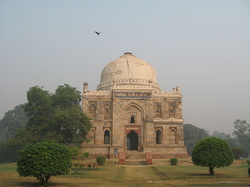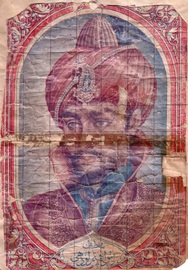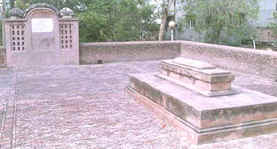The Lodhi dynasty in India arose around 1451 after the Sayyid dynasty. The Lodhi Empire was established by the Ghizlai tribe of the Afghans. They formed the last phase of the Delhi Sultanate. There were three main rulers in the history of Lodhi dynasty. All three of them have been discussed in detail in the following lines. So read on about the Lodhi dynasty history.
1- Buhlul Khan Lodhi
Bahlul belonged to the Shahu Khel clan of the Lodhi's. Bahlul's grandfather Malik Bahram settled in Multan during the reign of Firuz Shah Tughluq and took service under the governor of Multan, Malik Mardan Daulat. Malik Bahram had five sons. His eldest son, Malik Sultan Shah Lodhi later served under the Sayyid dynasty ruler Khizar Khan and distinguished himself by killing in the battle later's worst enemy Mallu Iqbal Khan. He was rewarded with the title of Islam Khan and in 1419 appointed the governor of Sirhind. Bahlul, the son of Malik Kala, the younger brother of Malik Sultan was married to Malik Sultan's daughter. In his youth, he was involved in the trading of horses and once sold his finely bred horses to the Sayyid dyansty Sultan Muhammad Shah. As a payment he was granted a pargana and raised to the status of amir. After the death of Malik Sultan, he became the governor of Sirhind. He was allowed to add Lahore to his charge. Once, Sultan Muhammad Shah asked for his help when the Malwa Sultan Mahmud Shah I invaded his territory. Bahlul joined the imperial army with 20,000 mounted soldiers. By his clevernees, he was able to project himself as a victor over the army of the Malwa Sultan and Sultan Muhammad Shah conferred on him the title of Khan-i-Khanan. He also accepted Bahlul's occupation over a large part of Punjab.
In 1443, Bahlul attacked Delhi but he did not succeed. During the reign of last Sayyid ruler Sultan Alam Shah, Bahlul again made another unsuccessful attempt to capture Delhi in 1447. Finally, when Alam Shah retired to Badaun in 1448, a minister of Alam Shah, Hamid Khan invited him to occupy the throne of Delhi. After the voluntary abdication of the throne by Alam Shah, Bahlul Shah ascended the throne of Delhi on April 19, 1451 and adopted the title of Bahlul Shah Ghazi. Alam Shah continued to live in Badaun till his death in July 1478.
Today, a humble tomb of the founder of Lodi dynasty, lies close to the shrine, noted Sufi saint, Nasiruddin Chirag-e-Delhi, in a locality that goes by his name, 'Chirag Delhi' .
The Reign*
After ascending to the throne, Bahlul decided to dispose of Hamid Khan. His cousin and brother-in-law Qutb Khan imprisoned Hamid Khan and he disappeared from the scene.
Bahlul Khan did much to stop rebellions and uprisings in his territories, and extended his holdings over Gwalior, Jaunpur and upper Uttar Pradesh. In 1486, he appointed his son, Babrak Shah as viceroy of Jaunpur. In time, this proved to be problematic, as his second son, Nizam Khan (Sikandar Lodi) was named successor, and a power struggle ensued upon his death in 1489.

2- Sikandar Lodhi
He became Sultan upon the death of his father, Bahlul Khan Lodhi, on July 17, 1489. His rise to power was troublesome, with his older brother, Barbak Shah, the viceroy of Jaunpur, also staking a claim to the throne despite their father's nomination of Sikandar. However, he was able to claim the throne through delegation and was able to avoid massive bloodshed. In fact, he allowed his brother to keep governing Jaunpur, while also settling differences with an uncle, Alam Khan, who was also suspected of usurping the throne.
Sikandar proved to be a capable ruler who was kind to his Muslim subjects, but was extremely harsh to his Hindu subjects. He expanded Lodi territory into the regions of Gwalior and Bihar. He made a treaty with Alauddin Hussain Shah and his kingdom of Bengal. He was able to bring his native Afghan nobles under his control, and encouraged trade across his holdings. In 1503, he commissioned the building of the present-day city of Agra.
Much has been written about his religious intolerance. Bodhan - a Hindu renunciate (sadhu), was burnt alive for saying the following: Islam and Hindu Dharma are both equally acceptable to God if followed with sincerity.
The History of the Delhi sultanate by M.M. Syed says the following about him: he frequently razed temples to the ground and erected mosques in their place, as evidenced by his behaviour at Mandrail, Utgir, and Narwar. At Mathura he prevented Hindus from bathing in their sacred ghats or having themselves shaved. The stones of broken Hindu idols were given away to butchers to be used as weights.
Among the administrative changes made by Sikandar Lodi was the installation of Persian language as the official language for the accountancy in India. 1974. Mat̲nawī-yi mihr u māh (905H.). Publication of the Iran Pakistan Institute of Persian Studies, serial no.
Sikandar Lodhi tried to conquer the Gwalior fort, and he attacked 5 times,but was failed all the five times by the king of Gwalior Maharaja Mansingh. He developed Agra as his second capital (after Delhi), as it took a lot of time to travel from Delhi to Gwalior. Finally he attacked a small region, near Gwalior named Narwar, and he had to wait 11 months at the gates of the Narwar fort, after 11 months when the people found that nothing had left to eat, they surrendered to Sikandar lodi. Once again he attacked on Gwalior, and was defeated by Maharaja Mansingh and his wife Mrignayani.
He died in 1517 and has an elaborate burial tomb that resides in Lodi Gardens, Delhi.
He became Sultan upon the death of his father, Bahlul Khan Lodhi, on July 17, 1489. His rise to power was troublesome, with his older brother, Barbak Shah, the viceroy of Jaunpur, also staking a claim to the throne despite their father's nomination of Sikandar. However, he was able to claim the throne through delegation and was able to avoid massive bloodshed. In fact, he allowed his brother to keep governing Jaunpur, while also settling differences with an uncle, Alam Khan, who was also suspected of usurping the throne.
Sikandar proved to be a capable ruler who was kind to his Muslim subjects, but was extremely harsh to his Hindu subjects. He expanded Lodi territory into the regions of Gwalior and Bihar. He made a treaty with Alauddin Hussain Shah and his kingdom of Bengal. He was able to bring his native Afghan nobles under his control, and encouraged trade across his holdings. In 1503, he commissioned the building of the present-day city of Agra.
Much has been written about his religious intolerance. Bodhan - a Hindu renunciate (sadhu), was burnt alive for saying the following: Islam and Hindu Dharma are both equally acceptable to God if followed with sincerity.
The History of the Delhi sultanate by M.M. Syed says the following about him: he frequently razed temples to the ground and erected mosques in their place, as evidenced by his behaviour at Mandrail, Utgir, and Narwar. At Mathura he prevented Hindus from bathing in their sacred ghats or having themselves shaved. The stones of broken Hindu idols were given away to butchers to be used as weights.
Among the administrative changes made by Sikandar Lodi was the installation of Persian language as the official language for the accountancy in India. 1974. Mat̲nawī-yi mihr u māh (905H.). Publication of the Iran Pakistan Institute of Persian Studies, serial no.
Sikandar Lodhi tried to conquer the Gwalior fort, and he attacked 5 times,but was failed all the five times by the king of Gwalior Maharaja Mansingh. He developed Agra as his second capital (after Delhi), as it took a lot of time to travel from Delhi to Gwalior. Finally he attacked a small region, near Gwalior named Narwar, and he had to wait 11 months at the gates of the Narwar fort, after 11 months when the people found that nothing had left to eat, they surrendered to Sikandar lodi. Once again he attacked on Gwalior, and was defeated by Maharaja Mansingh and his wife Mrignayani.
He died in 1517 and has an elaborate burial tomb that resides in Lodi Gardens, Delhi.

3- Ibrahim Lodhi King of INDIA.
Ibrahim Lodhi (died April 21, 1526) was the last ruler of the Delhi Sultanate. He was an Afghan (specifically of the Ghilzai tribe of Pashtuns) who ruled over much of India from 1517-1526, when he was defeated by the Mughals, who established a new dynasty that would last some three centuries.
Ibrahim attained the throne upon the death of his father, Sikandar Lodhi, but was not blessed with the same ruling capability. He faced a number of rebellions. Rana Sanga extended his empire right up to western UP and threatened to attack Agra. There was rebellion in the east also. He also displeased the nobility when he replaced old and senior commanders by younger ones who were loyal to him. He was feared and loathed by his subjects. His Afghan nobility eventually invited Babur of Kabul to invade India.
Ibrahim died in the Battle of Panipat, where Babur's superior fighters and the desertion of many of Lodhi's soldiers led to his downfall, despite superior troop numbers.
Ibrahim Lodhi (died April 21, 1526) was the last ruler of the Delhi Sultanate. He was an Afghan (specifically of the Ghilzai tribe of Pashtuns) who ruled over much of India from 1517-1526, when he was defeated by the Mughals, who established a new dynasty that would last some three centuries.
Ibrahim attained the throne upon the death of his father, Sikandar Lodhi, but was not blessed with the same ruling capability. He faced a number of rebellions. Rana Sanga extended his empire right up to western UP and threatened to attack Agra. There was rebellion in the east also. He also displeased the nobility when he replaced old and senior commanders by younger ones who were loyal to him. He was feared and loathed by his subjects. His Afghan nobility eventually invited Babur of Kabul to invade India.
Ibrahim died in the Battle of Panipat, where Babur's superior fighters and the desertion of many of Lodhi's soldiers led to his downfall, despite superior troop numbers.

Tomb*
His tomb is often mistaken to be the Sheesh Gumbad within Lodi Gardens Delhi, though is actually situated in near the tehsil office in Panipata, close to the Dargah of Sufi saint Bu Ali Shah Qalandar. It is a simple rectangular structure on a high platform approached by a flight of steps. The tomb was renovated by the British, and an inscription mentioning Ibrahim Lodi’s defeat at the hands of Babur and the renovation was included in 1866.
His tomb is often mistaken to be the Sheesh Gumbad within Lodi Gardens Delhi, though is actually situated in near the tehsil office in Panipata, close to the Dargah of Sufi saint Bu Ali Shah Qalandar. It is a simple rectangular structure on a high platform approached by a flight of steps. The tomb was renovated by the British, and an inscription mentioning Ibrahim Lodi’s defeat at the hands of Babur and the renovation was included in 1866.
